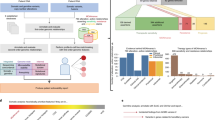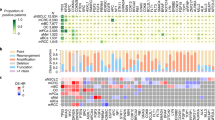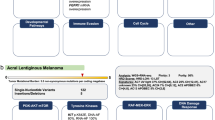Abstract
Underpinning the vision of precision medicine is the concept that causative mutations in a patient's cancer drive its biology and, by extension, its clinical features and treatment response. However, considerable between-patient heterogeneity in driver mutations complicates evidence-based personalization of cancer care. Here, by reanalyzing data from 1,540 patients with acute myeloid leukemia (AML), we explore how large knowledge banks of matched genomic–clinical data can support clinical decision-making. Inclusive, multistage statistical models accurately predicted likelihoods of remission, relapse and mortality, which were validated using data from independent patients in The Cancer Genome Atlas. Comparison of long-term survival probabilities under different treatments enables therapeutic decision support, which is available in exploratory form online. Personally tailored management decisions could reduce the number of hematopoietic cell transplants in patients with AML by 20–25% while maintaining overall survival rates. Power calculations show that databases require information from thousands of patients for accurate decision support. Knowledge banks facilitate personally tailored therapeutic decisions but require sustainable updating, inclusive cohorts and large sample sizes.
This is a preview of subscription content, access via your institution
Access options
Access Nature and 54 other Nature Portfolio journals
Get Nature+, our best-value online-access subscription
$29.99 / 30 days
cancel any time
Subscribe to this journal
Receive 12 print issues and online access
$209.00 per year
only $17.42 per issue
Buy this article
- Purchase on Springer Link
- Instant access to full article PDF
Prices may be subject to local taxes which are calculated during checkout






Similar content being viewed by others
References
Van Allen, E.M. et al. Whole-exome sequencing and clinical interpretation of formalin-fixed, paraffin-embedded tumor samples to guide precision cancer medicine. Nat. Med. 20, 682–688 (2014).
Mardis, E.R. Genome sequencing and cancer. Curr. Opin. Genet. Dev. 22, 245–250 (2012).
Garraway, L.A. & Lander, E.S. Lessons from the cancer genome. Cell 153, 17–37 (2013).
McDermott, U., Downing, J.R. & Stratton, M.R. Genomics and the continuum of cancer care. N. Engl. J. Med. 364, 340–350 (2011).
Papaemmanuil, E. et al. Clinical and biological implications of driver mutations in myelodysplastic syndromes. Blood 122, 3616–3627, quiz 3699 (2013).
Cancer Genome Atlas Network. Comprehensive molecular portraits of human breast tumors. Nature 490, 61–70 (2012).
Imielinski, M. et al. Mapping the hallmarks of lung adenocarcinoma with massively parallel sequencing. Cell 150, 1107–1120 (2012).
Manolio, T.A. et al. Global implementation of genomic medicine: we are not alone. Sci. Transl. Med. 7, 290ps13 (2015).
Collins, F.S. & Varmus, H. A new initiative on precision medicine. N. Engl. J. Med. 372, 793–795 (2015).
Papaemmanuil, E. et al. Genomic classification and prognosis in acute myeloid leukemia. N. Engl. J. Med. 374, 2209–2221 (2016).
Cancer Genome Atlas Research Network. Genomic and epigenomic landscapes of adult de novo acute myeloid leukemia. N. Engl. J. Med. 368, 2059–2074 (2013).
Gale, R.P., Wiernik, P.H. & Lazarus, H.M. Should persons with acute myeloid leukemia have a transplant in first remission? Leukemia 28, 1949–1952 (2014).
Döhner, H. et al. Diagnosis and management of acute myeloid leukemia in adults: recommendations from an international expert panel, on behalf of the European LeukemiaNet. Blood 115, 453–474 (2010).
Koreth, J. et al. Allogeneic stem cell transplantation for acute myeloid leukemia in first complete remission: systematic review and meta-analysis of prospective clinical trials. J. Am. Med. Assoc. 301, 2349–2361 (2009).
Flowers, M.E.D. & Martin, P.J. How we treat chronic graft-versus-host disease. Blood 125, 606–615 (2015).
Burnett, A.K. et al. Curability of patients with acute myeloid leukemia who did not undergo transplantation in first remission. J. Clin. Oncol. 31, 1293–1301 (2013).
Schlenk, R.F. et al. The value of allogeneic and autologous hematopoietic stem cell transplantation in prognostically favorable acute myeloid leukemia with double-mutant CEBPA. Blood 122, 1576–1582 (2013).
Doria-Rose, V.P., Harlan, L.C., Stevens, J. & Little, R.F. Treatment of de novo acute myeloid leukemia in the United States: a report from the Patterns of Care program. Leuk. Lymphoma 55, 2549–2555 (2014).
Cressman, S. et al. Economic impact of genomic diagnostics for intermediate-risk acute myeloid leukemia. Br. J. Haematol. 174, 526–535 (2016).
Khera, N., Zeliadt, S.B. & Lee, S.J. Economics of hematopoietic cell transplantation. Blood 120, 1545–1551 (2012).
Forbes, S.A. et al. COSMIC: exploring the world's knowledge of somatic mutations in human cancer. Nucleic Acids Res. 43, D805–D811 (2015).
Schoenfeld, D.A. Sample-size formula for the proportional-hazards regression model. Biometrics 39, 499–503 (1983).
Schmoor, C., Sauerbrei, W. & Schumacher, M. Sample-size considerations for the evaluation of prognostic factors in survival analysis. Stat. Med. 19, 441–452 (2000).
Jameson, J.L. & Longo, D.L. Precision medicine—personalized, problematic and promising. N. Engl. J. Med. 372, 2229–2234 (2015).
Stone, R.M. et al. The multi-kinase inhibitor midostaurin (M) prolongs survival compared with placebo (P) in combination with daunorubicin (D)-cytarabine (C) induction (ind), high-dose C consolidation (consol) and as maintenance (maint) therapy in newly diagnosed acute myeloid leukemia (AML) patients (pts) age 18–60 with FLT3 mutations (muts): an international prospective randomized (rand) P-controlled double-blind trial. Blood 126, 6 (2015).
Ishwaran, H., Kogalur, U.B., Blackstone, E.H. & Lauer, M.S. Random survival forests. Ann. Appl. Stat. 2, 841–860 (2008).
Ley, T.J. et al. DNMT3A mutations in acute myeloid leukemia. N. Engl. J. Med. 363, 2424–2433 (2010).
Welch, J.S. et al. The origin and evolution of mutations in acute myeloid leukemia. Cell 150, 264–278 (2012).
Delhommeau, F. et al. Mutation in TET2 in myeloid cancers. N. Engl. J. Med. 360, 2289–2301 (2009).
Schlenk, R.F. et al.; German-Austrian Acute Myeloid Leukemia Study Group. All-trans retinoic acid as adjunct to intensive treatment in younger adult patients with acute myeloid leukemia: results of the randomized AMLSG 07-04 study. Ann. Hematol. 95, 1931–1942 (2016).
Schlenk, R.F. et al. Phase 3 study of all-trans retinoic acid in previously untreated patients 61 years or older with acute myeloid leukemia. Leukemia 18, 1798–1803 (2004).
Schlenk, R.F. et al. Prospective evaluation of allogeneic hematopoietic stem cell transplantation from matched related and matched unrelated donors in younger adults with high-risk acute myeloid leukemia: German–Austrian trial AMLHD98A. J. Clin. Oncol. 28, 4642–4648 (2010).
Therneau, T.M., Grambsch, P.M. & Pankratz, V.S. Penalized survival models and frailty. J. Comput. Graph. Stat. 12, 156–175 (2003).
Shah, R.D. & Samworth, R.J. Variable selection with error control: another look at stability selection. J. R. Stat. Soc. Series B Stat. Methodol. 75, 55–80 (2013).
Acknowledgements
We thank C. Holmes for stimulating discussions. We gratefully acknowledge D. Weber for clinical data managing, V. Teleanu for assistance in cytogenetics data classification and S. Kayser for assistance in morphological evaluation. This work was supported by grants from the Wellcome Trust (077012/Z/05/Z; P.J.C.), the Bloodwise charity (P.J.C.), the Leukemia and Lymphoma Society (P.J.C.) and the Deutsche Krebshilfe (109675; K.D.), in part by grants from the German Bundesministerium für Bildung und Forschung (BMBF) (01GI9981 (H.D.) and 01KG0605 (R.F.S. and H.D.)), by a Wellcome Trust Senior Clinical Research Fellowship (WT088340MA; P.J.C.), by an EHA early career fellowship (E.P.), and by the Deutsche Forschungsgemeinschaft (project B3, Sonderforschungsbereich (SFB) 1074; K.D. and L.B.); H.D. is coordinating investigator. L.B. is a Heisenberg Professor of the DFG (BU 1339/3-1). We are grateful to all members of the German–Austrian AML Study Group (AMLSG) for their participation in this study and for providing patient samples; a list of participating institutions and investigators appears in the Appendix of Papaemmanuil et al.5. AMLSG treatment trials were in part supported by Amgen and DKH grant 109675.
Author information
Authors and Affiliations
Contributions
M.G. developed the statistical methods, analyzed data and wrote the manuscript and supporting information, with input from E.P. and P.J.C. E.P. prepared and curated the genetic and clinical data. I.M. analyzed TCGA data. R.F.S., H.D., K.D., L.B., V.I.G., P.P., M.H., F.T. and A.G., along with all of the institutions contributing to the study group (AMLSG), recruited patients in this study, and collated and contributed clinical data. N.B., P.G. and U.M. provided input into analyses and interpretation of results. E.P., K.D., H.D., R.F.S. and P.J.C. initiated the study. P.J.C. and H.D. wrote the manuscript and are joint corresponding authors.
Corresponding authors
Ethics declarations
Competing interests
The authors declare no competing financial interests.
Integrated supplementary information
Supplementary Figure 1 Constellations of risk factors for overall survival.
(a) Predicted log-hazard for overall survival versus patient outcome (color) of 1,540 patients. The black curve denotes the censored fraction, averaged over 50 adjacent patients. (b) Radar plots showing the distribution of aggregated risk in seven categories for five selected patients. Color indicates the observed survival, with solid lines around each symbol denoting an observed death and censored outcome otherwise. NK, normal karyotype; HR, hazard ratio. (c) Constellations of risk factors for 1,024 randomly selected patients, arranged by hierarchical clustering according to their risk profiles and laid out in 2D according to a Hilbert curve to preserve the proximity of the clustering. Related to Figure 2.
Supplementary Figure 2 Predicted effects of allograft in CR1 or after relapse.
(a–d) Predicted outcome for four patients, under a therapy regimen with standard chemotherapy in CR1 and allograft after relapse (left) or with allograft in CR1 (right). The height of each colored segment corresponds to the probability of being alive in remission (purple), alive after relapse (yellow), dead after relapse (green) or dead without relapse (blue). The bars at the bottom illustrate the actual outcome and treatment the patient received. Predictions are based on a model where the given patient was excluded. Related to Figure 3.
Supplementary Figure 3 Effects of allogeneic transplants.
(a–e) Kaplan–Meier curves for patients from different ELN risk groups. In each individual panel, patients were stratified by their predicted benefit from allografts in CR1 and by whether they had received allogeneic transplant in CR1. There was a clear benefit to allogeneic transplants over chemotherapy in CR1 in the 12% of patients we predicted to have >10 percentage points improvement in absolute survival (HR = 0.5, 95% CI = 0.3–0.81, P = 0.003, ELN-stratified Cox proportional-hazards model). In contrast, for the other 88% of patients, the stratified hazard ratio was found to be HR = 0.74 with 95% CI = 0.55–0.89 (P = 0.01), matching our predictions of lower benefit from transplant of these patients in CR1. Related to Figure 4c.
Supplementary Figure 4 Predicted population-level survival gains for different estimates of overall benefit of early allograft.
(a) Scenario with low benefit of allografts in CR1 (5% quantile of all predictions). This scenario is based on the high toxicity of allografts, especially in elderly patients. Overall, only about one-third of patients (in CR, younger than 60 years) would benefit from an early allograft, as indicated by the decline of the red curve, beyond 75% total allografts (CR1 + relapse combined). The added survival of the knowledge bank would be about 1%, and the same survival could be achieved using much fewer allografts. (b) Scenario with intermediate benefit (50% quantile of all predictions), similar to Figure 4d. (c) Scenario with high benefit (95% quantile of all predictions). In this limit case, all patients are predicted to benefit from early allografts and there is no decline of the curves. Related to Figure 5.
Supplementary Figure 5 Screenshot of the multistage calculator.
The calculator is available online at http://cancer.sanger.ac.uk/aml-multistage. A docker image can be installed locally from https://hub.docker.com/r/mg14/aml-multistage. All source code can be found at http://github.com/mg14/aml-multistage.
Supplementary Figure 6 Implications of the number of genes sequenced.
(a) Subsampling of genes shows that the predicted variation in risk increases linearly with the average number of mutations per patient. This allows extrapolation from this cohort (111 genes sequenced; average of 2.3 driver mutations per patient) to an exome study (TCGA: ~20,000 genes sequenced; ~3.7 driver mutations predicted per patient. (b) Algorithmic imputation of missing genes based on the multistage model, as implemented in the web portal. Shown is the concordance if only information on a subset of genes is present. With seven genes, the concordance is about 72% and plateaus at about 30 genes entered into the portal.
Supplementary Figure 7 Extrapolated power for detecting novel associations.
(a) Power calculations showing the expected ability to detect significant genomic features as a function of effect and mutation frequency for cohort sizes of 100, 1,540 and 10,000 patients. Shown are selected terms and the distribution of effect sizes in the random-effects model. (b) Distribution of P values (y axis) in comprehensive simulations using 100 (+), 1,000 (Δ) and 10,000 (o) simulated patients, respectively. P values are shown as a function of the product of N (sample size), ψ (uncensored fraction), p (mutation frequency) and β2 (squared log-hazard), as indicated on the x axis. The solid line indicates an analytical approximation by Schoenfeld, described in Schmoor (2000).
Supplementary information
Supplementary Text and Figures
Supplementary Figures 1–7 and Supplementary Note (PDF 15110 kb)
Supplementary Tables 1–6
Supplementary Tables 1–6 (XLSX 149 kb)
Rights and permissions
About this article
Cite this article
Gerstung, M., Papaemmanuil, E., Martincorena, I. et al. Precision oncology for acute myeloid leukemia using a knowledge bank approach. Nat Genet 49, 332–340 (2017). https://doi.org/10.1038/ng.3756
Received:
Accepted:
Published:
Issue Date:
DOI: https://doi.org/10.1038/ng.3756
This article is cited by
-
Validation and refinement of the 2022 European LeukemiaNet genetic risk stratification of acute myeloid leukemia
Leukemia (2023)
-
Johann Gregor Mendel: the victory of statistics over human imagination
European Journal of Human Genetics (2023)
-
Application of the CIBMTR One Year Survival Outcomes Calculator as a tool for retrospective analysis
Bone Marrow Transplantation (2023)
-
Convergent somatic evolution commences in utero in a germline ribosomopathy
Nature Communications (2023)
-
Unsupervised meta-clustering identifies risk clusters in acute myeloid leukemia based on clinical and genetic profiles
Communications Medicine (2023)



